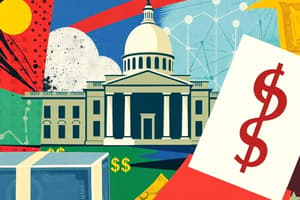Podcast
Questions and Answers
What does deficit spending require a government to do?
What does deficit spending require a government to do?
- Cut taxes
- Lay off workers
- Hire more workers
- Take on debt (correct)
When a government creates a budget, it is seeking a way to:
When a government creates a budget, it is seeking a way to:
- Spend as much revenue as possible
- Return as much money to taxpayers as possible
- Allocate money to programs and projects (correct)
- Cut spending to a bare minimum
Which of these effects of expansionary spending would a government most want to avoid?
Which of these effects of expansionary spending would a government most want to avoid?
- Growth in consumer spending
- Higher inflation (correct)
- Growth in production
- Higher employment
The graph shows the federal debt between 1993 and 2013. What trend about the federal debt does the graph reveal?
The graph shows the federal debt between 1993 and 2013. What trend about the federal debt does the graph reveal?
The graph shows government spending as a percentage of GDP from 1990 to 2012. At its peak, government spending made up about:
The graph shows government spending as a percentage of GDP from 1990 to 2012. At its peak, government spending made up about:
The graph shows the federal budget from 1980 to 2010. In which period did the federal budget show the greatest deficit?
The graph shows the federal budget from 1980 to 2010. In which period did the federal budget show the greatest deficit?
When revenues are higher than expenditures in a budget, that budget:
When revenues are higher than expenditures in a budget, that budget:
This diagram shows a government's approach to taxing and spending. Which of the following would be a good title for this diagram?
This diagram shows a government's approach to taxing and spending. Which of the following would be a good title for this diagram?
What is the main goal in creating the federal budget?
What is the main goal in creating the federal budget?
When governments inject money into the economy, which of the following are their goals? (Check all that apply)
When governments inject money into the economy, which of the following are their goals? (Check all that apply)
Flashcards are hidden until you start studying
Study Notes
Deficit Spending and Government Debt
- Deficit spending requires a government to take on debt to finance its expenditures.
- The federal debt has been on an increasing trend from 1993 to 2013, indicating persistent borrowing.
Government Budgeting
- When creating a budget, a government aims to allocate money effectively to various programs and projects.
- A budget that shows revenues higher than expenditures signifies a surplus, while the opposite indicates a deficit.
Expansionary Spending Effects
- While higher employment, growth in production, and consumer spending are desirable outcomes of expansionary spending, higher inflation is an effect to avoid.
Government Spending as a Percentage of GDP
- At its peak from 1990 to 2012, government spending accounted for about one-quarter of GDP.
Federal Budget Deficits
- The greatest federal budget deficit occurred from 2000 to 2010, reflecting increased spending without corresponding revenue.
Fiscal Policy Insights
- Fiscal policy encapsulates a government's strategies for taxing and spending to manage the economy, targeting stability, reduced unemployment, and improved production.
- Effective fiscal policy also encompasses encouraging competition within the market.
Federal Budget Management Goals
- The primary goal in crafting the federal budget focuses on managing government tax revenue and expenditures for economic balance and stability.
Studying That Suits You
Use AI to generate personalized quizzes and flashcards to suit your learning preferences.




